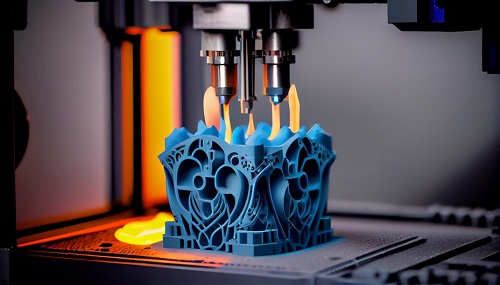



 CN/EN
CN/EN




 CN/EN
CN/EN
3D printing has advanced quickly. It finds applications in automotive, aerospace, and healthcare thanks to its ability to fabricate complex custom parts efficiently. However, standardized processes, IP protection, materials supply chains, and market education require further work before 3D printing completely industrializes and disrupts traditional manufacturing. Global collaborations aim to solve these challenges and propel industrial 3D printing technology into mainstream use across sectors.

Industrial Application of 3D Printing Technology
Industrial 3D printing facilitates mass production of parts in small batches. It achieves this due to its ability to quickly produce complex geometries. This makes it suitable for manufacturing customized components. Factories can leverage precise 3D printing to produce items on demand locally, eliminating long lead times.
Advantages of industrial 3D printing include improving production efficiency by reducing tooling costs and setup times. It facilitates on-demand manufacturing and minimizes waste. Manufacturers have replaced traditional production processes with 3D printing to reduce costs through part consolidation and functional integration.
While the recent online trend of 3D-printed carrot knives and telescopic swords may seem frivolous, it highlights a crucial aspect of 3D printing technology: its ability to create intricate details within seemingly simple designs. These toys might not be industrial applications themselves, but the technology's ability to create intricate details within their simple forms demonstrates its potential. This capability to create complex geometries unlocks a world of possibilities for various industries like medical implants or aerospace components.
Challenges in the Development of 3D Printing Industrialization
While 3D printing shows promise for mass production applications, several challenges currently limit its full-scale industrial adoption. Establishing standards and overcoming issues around intellectual property, materials, and market awareness are crucial obstacles to address.
1. Technical Standards and Compatibility
The lack of agreed-upon standards for file formats, materials parameters, and machine operations hinders collaboration. Incompatibilities between printers, software, and scanners from different brands create roadblocks. This siloed approach inhibits part-sharing and joint production planning across enterprises.
2. Intellectual Property Protection
Without adequate digital rights management of industrial 3D printing files, intellectual property is vulnerable to theft. Designers require assurances that their creations will not be illegally distributed or reproduced online through piracy sites. Effective safeguards are critical for innovators’ commercial success.
3. Raw Material Supply and Costs
3D printing relies on imported raw materials with volatile and unpredictable availability and pricing. This dependency hurts supply chain efficiency and manufacturing economics. Identifying alternative domestic material sources could help mitigate risks from supply disruptions and inflation.
4. Market Education and Awareness
Poor understanding of real production capabilities beyond prototyping limits demand. More education is needed on the suite of industries that can leverage the technology. Targeted marketing showcasing total cost analysis versus traditional methods can build stronger customer pull.

Strategies to Promote the Industrial Development of 3D Printing
Overcoming challenges and maximizing opportunities will require coordinated efforts between research institutions and policymakers. Strategic guidance and planning are important to drive widespread industrialization.
1. Government Support and Policy Guidance
Favorable policies around digital protection, funding incentives, and education priorities can spur greater progress. Governments coordinate standards-setting and research initiatives to establish a foundation for large-scale production. Tax credits for additive manufacturing equipment modernization encourage factory adoption.
2. Investment and R&D
Increased R&D accelerates the development of high-speed industrial 3D printing machines, new materials, and advanced applications. Venture investment commercializes innovations to realize full potential and demonstrate economic viability at scale. Strategic partnerships with manufacturers facilitate applied research.
3. Build a Partnership
Cross-sector collaborations merge complementary expertise to create turnkey additive manufacturing solutions. Partnerships validate technologies and smooth integration into regional supply chains through joint pilots. Production consortiums refine processes for specific industry needs.
4. Cultivate Professional Talents
Educational programs equip the future industrial 3D printing workforce with critical design, operation, and quality control skills. Certification ensures that high-caliber technicians support industrial production needs and drive continuous improvement. Associations promote career opportunities and professional 3D printing development.
Conclusion
The development of industrial 3D printing technology holds immense importance and prospects for global manufacturing. With its ability to facilitate mass customization, reduce lead times, minimize waste, and streamline supply chains, additive manufacturing promises widespread benefits if adopted at scale. As barriers to industrialization like standardization, intellectual property protection, materials sourcing, and skills gaps are addressed through coordinated efforts, the potential of 3D printing can be fully realized. Events like TCT 2024 catalyze this transformation by convening industry players.
At the leading annual conference, attendees can network, gain insights on the latest innovations, and explore opportunities through an extensive expo and programming. TCT 2024 provides a forum to evaluate requirements and technology optimizing production. Increased utilization is empowering on-demand, distributed industrial 3D printing manufacturing for a sustainable future. Visit TCT Asia’s website to learn more about industrial additive insights and this pivotal event driving further development.

Join us at TCT Asia, connect with industry innovators as you explore the entire AM ecosystem including design, materials, hardware, software, post-processing, and quality. 10,000+ professionals will unite to hear about the latest trends, explore the latest immersive AM technologies and find solutions to their AM challenges. Make sure you are there too.

TCT ASIA 2024
Tuesday 7th May 09:00 - 17:30
Wednesday 8th May 09:00 - 17:30
Thursday 9th May 09:00 - 15:00
NECC(Shanghai)7.1&8.1H